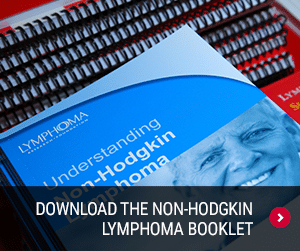
What is Lymphoma?
Diffuse Large B-Cell Lymphoma
Diffuse large B-cell lymphoma (DLBCL) is the most common type of non-Hodgkin lymphoma (NHL) in the United States and worldwide, accounting for about 22 percent of newly diagnosed cases of B-cell NHL in the United States. More than 18,000 people are diagnosed with DLBCL each year.
Diffuse large B-cell lymphoma is an aggressive (fast-growing) NHL that affects B-lymphocytes. Lymphocytes are one type of white blood cell. B-cells are lymphocytes that make antibodies to fight infections and are an important part of the lymphatic system.
Although it can occur in childhood, the occurrence of DLBCL generally increases with age, and most patients are over the age of 60 at diagnosis.
DLBCL can develop in the lymph nodes or in “extranodal sites” (areas outside the lymph nodes) such as the gastrointestinal tract, testes, thyroid, skin, breast, bone, brain, or essentially any organ of the body. It may be localized (in one spot) or generalized (spread throughout the body). Despite being an aggressive lymphoma, DLBCL is considered potentially curable.
Diffuse Large B-Cell Lymphoma Subtypes
A number of DLBCLs have been categorized into subtypes which differ with respect to certain characteristics:
- T-cell/histiocyte-rich B-cell lymphoma: When viewed under a microscope, this form of DLBCL looks like a few scattered large and atypical B-cells in a background of many normal T cells and histiocytes, which are cells that migrate from bone marrow into tissues.
- Primary DLBCL of the central nervous system (CNS): This refers to all DLBCLs that originate in either the brain or the eye. Occasionally, patients who do not have this subtype may still develop secondary DLBCL of the CNS, which occurs when the lymphoma moves into the brain or spinal cord at a later time.
- Primary cutaneous DLBCL, leg type: This type of DLBCL consists of large transformed B-cells that typically appear as red or bluish-red tumors. Despite its name, the disease can involve the trunk, arms, legs, buttocks, or anywhere on the body. These lymphomas can also spread to areas other than just the skin.
- Epstein-Barr virus (EBV)-positive DLBCL of the elderly: This form of DLBCL usually occurs in patients who are age 50 or older and test positive for EBV.
- DLBCL not otherwise specified (NOS): When DLBCL doesn’t fall into one of the subtypes listed above, it is classified as DLBCL not otherwise specified (NOS). A large number of diagnoses fall into this category. In western countries, about 25 to 30 percent of NHL cases diagnosed in adults are DLBCL-NOS, and this percentage is higher in developing countries. There are other ways of categorizing cases of DLBCL-NOS into molecular subgroups based on their genetic and immunophenotypic characteristics.
Download the Fact Sheet
To learn more about DLBCL, download the Diffuse Large B-Cell Lymphoma Fact Sheet.


